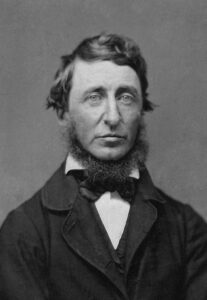
Henry David Thoreau, in 1856.
A Thoreau awareness of climate change
By Thomas Christopher
Sometimes insights come from unexpected sources. Twenty years ago, Dr. Richard Primack, a botanist at Boston University changed his focus from tropical rainforests to what was happening in response to climate change in the woods and fields of Massachusetts. In particular, he began to study the effects of the warming climate on phenology, the scheduling of natural biological events such as bird migrations or the bloom time of various wildflowers in the spring. To make sense of this, he needed not only observations by himself and his students of contemporary phenologies, he also needed historic records against which to compare them. I was fascinated to learn that he found the latter in the writings of one of my heroes, Henry David Thoreau.
Thoreau is best remembered today as the author of the literary classic Walden and the political essay Civil Disobedience. He was also, however, a dedicated observer of nature as expressed in the countryside of his hometown, Concord, Massachusetts. Thoreau took hours-long walks daily and recorded in his journals what he had seen, starting in 1837 and continuing until 1861 (the year before his death). When Dr. Primack explored these journals, especially those covering the 1850s, he found a treasure trove of relevant data. For example, Thoreau had noted the bloom times of some 300 species of native plants, as well as the arrival time of various migrating birds and the dates when specific trees and shrubs began to leaf out in the spring.
By comparing Thoreau’s observations with his own and those of his students, Primack was able to chart the phenological changes that had occurred as the climate has warmed an average of 3°C. What he found was that different types of organisms reacted differently. A fundamental change was that of the native trees and shrubs, which are now leafing out some 10 days earlier in Concord than they did in the 1850s.
That may not sound like much, but in fact, it’s enough to markedly disrupt the general phenology of the woods. The new leaves provide food for plant-eating insects, spurring a population spike that is relied on by songbirds to feed their chicks. Yet the songbirds have not reacted to climate change to the extent of the trees, shrubs, and insects, so that they now run the danger of arriving after the spike of insects has passed. Additionally, some invasive plants that have been introduced into the landscape such as Norway maples, Japanese barberries, and Tartarian honeysuckles, have reacted more strongly than the native trees and shrubs, leafing out earlier so that they now have an additional advantage. As a rule, these invasives do not support the native insects
The difference in reactions to climate change has another implication for the ecology of the woods. Spring wildflowers have reacted less to the warming than trees, perhaps, Primack theorizes, because the wildflowers while dormant remain below ground whereas the trees are exposed to the air, which warms before the soil does. The wildflowers used to emerge first, taking advantage of the sunlight that filtered through the still bare tree canopy. Now the earlier leafing trees are threatening to shade out the wildflowers.
Weather records reveal that climate change is increasing another hazard to our wildlife. Climate change has simultaneously led to a weakening of the jet stream in the upper atmosphere, making southward intrusions of northern, frigid weather a common feature of our Northeastern springs. This has led to a seemingly contradictory situation in which earlier springs are frequently matched with hard frosts late in the season. These frosts can be fatal to flowers, young leaves, and even newly emerged insects. The native flora and fauna can typically recuperate from such setbacks, but they weaken these organisms. Hotter summers increase plants’ needs for water, increasing the danger of drought.
To succeed at their craft, gardeners need to be aware of the changes that climate change is wreaking. This knowledge should also encourage them to become advocates for taking the steps necessary to combat climate change. Because alert gardeners are well informed about natural systems – including phenology – they are well prepared to become advocates for environmental action in their communities.
To hear more about Dr. Primack’s work, and his advice on the role gardeners can, like Thoreau, play as citizen scientists, log onto the Berkshire Botanical Garden’s Growing Greener podcast at www.berkshirebotanical.org/growinggreener.
Be-a-Better-Gardener is a community service of Berkshire Botanical Garden, located in Stockbridge, Mass. Its mission, to provide knowledge of gardening and the environment through a diverse range of classes and programs, informs and inspires thousands of students and visitors each year. Thomas Christopher is a volunteer at Berkshire Botanical Garden and is the author or co-author of more than a dozen books, including Nature into Art and The Gardens of Wave Hill (Timber Press, 2019). He is the 2021 Garden Club of America’s National Medalist for Literature, a distinction reserved to recognize those who have left a profound and lasting impact on issues that are most important to the GCA. Christopher’s companion broadcast to this column, Growing Greener, streams on WESUFM.org, Pacifica Radio and NPR and is available at berkshirebotanical.org/growinggreener.

 Thomas Christopher is the co-author of “Garden Revolution” (Timber Press, 2016) and is a volunteer at Berkshire Botanical Garden. berkshirebotanical.org Be-a-Better-Gardener is a community service of Berkshire Botanical Garden, one of the nation’s oldest botanical gardens in Stockbridge, MA. Its mission to provide knowledge of gardening and the environment through 25 display gardens and a diverse range of classes informs and inspires thousands of students and visitors on horticultural topics every year. Thomas Christopher is the co-author of Garden Revolution (Timber press, 2016) and is a volunteer at Berkshire Botanical Garden. berkshirebotanical.org.
Thomas Christopher is the co-author of “Garden Revolution” (Timber Press, 2016) and is a volunteer at Berkshire Botanical Garden. berkshirebotanical.org Be-a-Better-Gardener is a community service of Berkshire Botanical Garden, one of the nation’s oldest botanical gardens in Stockbridge, MA. Its mission to provide knowledge of gardening and the environment through 25 display gardens and a diverse range of classes informs and inspires thousands of students and visitors on horticultural topics every year. Thomas Christopher is the co-author of Garden Revolution (Timber press, 2016) and is a volunteer at Berkshire Botanical Garden. berkshirebotanical.org.

